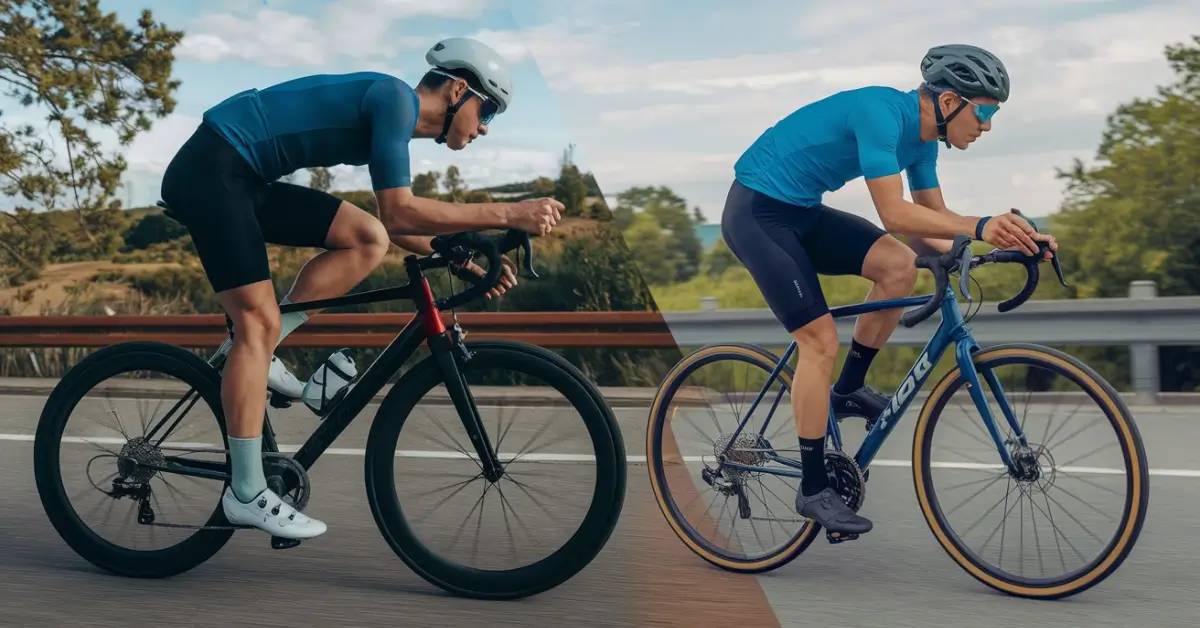Picking the perfect bike frame size isn’t just about numbers—it’s about comfort, control, and making every ride feel effortless. I’ve seen too many riders struggle with aches and awkward posture simply because they didn’t know how to choose bike frame size correctly. Believe me, doing it right makes all the difference! In this guide, I’ll break it down step by step, so you can determine the best fit for your height, riding style, and comfort. Let’s make sure you find a bike that feels like an extension of you!
Why Bike Frame Size Matters
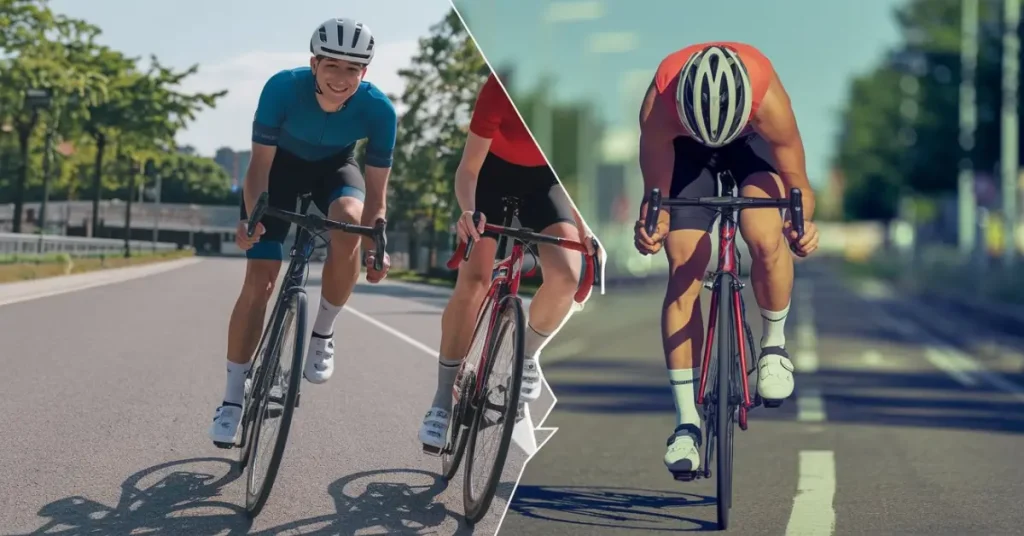
Ever ridden a bike that just didn’t feel right? Maybe your back ached, your knees felt strained, or you kept shifting in the saddle, trying to find a comfortable position. That’s what happens when the frame size is off—it turns a fun ride into a frustrating one. Picking the right size isn’t just about numbers; it’s about how you feel on the bike.
Comfort and Riding Posture
A well-fitted bike feels natural, almost like an extension of your body. When the frame size is right, you sit comfortably, your back stays relaxed, and your hands rest naturally on the handlebars. But if the bike is too big or too small, you’ll end up stretching too far or feeling cramped. Over time, this leads to soreness in your shoulders, neck, and lower back. The right fit makes every ride smooth and effortless.
Short Answer: A properly sized bike keeps your posture natural and prevents aches, making rides more enjoyable.
Performance and Efficiency
Think of your bike like a tool—it works best when it fits you perfectly. A frame that’s too big makes it harder to control the bike, while a small frame forces you into awkward positions that waste energy. When the size is right, every pedal stroke translates into smooth, efficient movement. You’ll ride faster, climb easier, and feel more stable on turns. Whether you’re cycling for fitness, commuting, or just having fun, the right frame size helps you get the most out of every ride.
Short Answer: The right bike frame size improves speed, control, and energy efficiency, making riding easier.
Risk of Injury from an Improper Fit
An ill-fitting bike isn’t just uncomfortable—it can actually lead to injuries. If the frame is too big, you might overextend your knees, causing strain over time. Too small? You’ll feel cramped, which can lead to knee pain, wrist discomfort, and even long-term joint problems. Proper bike fit helps prevent repetitive stress injuries, keeping your body aligned and your movements natural.
Short Answer: The wrong bike frame size can cause knee pain, backaches, and joint strain over time.
How to Determine Bike Frame Size
Choosing the right bike frame size isn’t rocket science, but it does take a little know-how. If you’ve ever felt like Goldilocks—one bike too big, another too small—you know how frustrating it can be. A bike should feel just right, giving you comfort and control. Let’s break it down step by step so you can find the perfect fit.
A. Understanding Bike Frame Measurements
What Is a Bike Frame Size?
Bike frame size is simply the length of the seat tube—the part of the frame that runs from the pedals up to the seat. It’s usually measured in inches (for mountain bikes) or centimeters (for road bikes). But that’s not the whole story.
Another key measurement is the top tube length—the horizontal bar between the seat and handlebars. This affects how far you have to reach, which can impact comfort and posture.
Short Answer: Bike frame size is based on the seat tube length, but top tube length also matters for comfort.
Road vs. Mountain vs. Hybrid Bike Frames
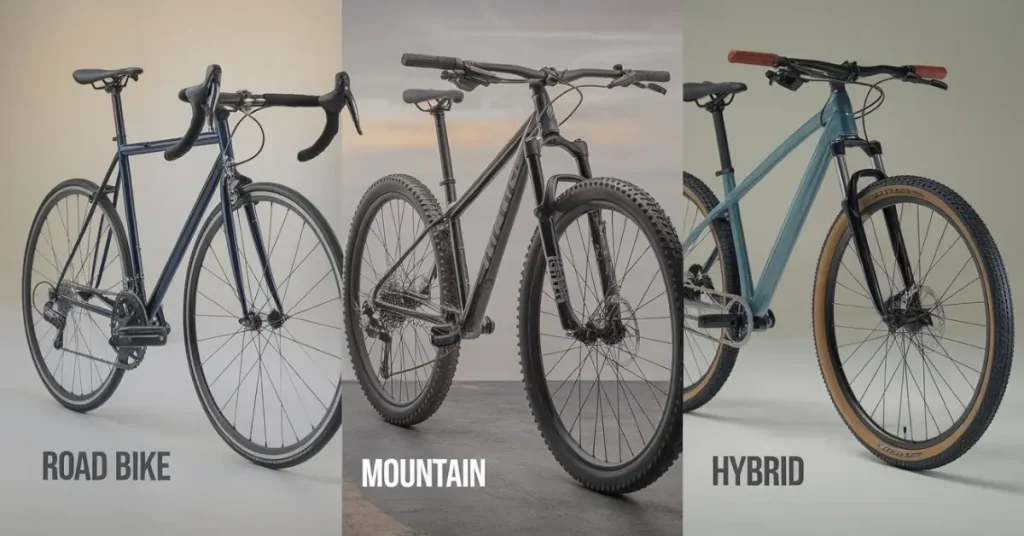
Not all bikes use the same sizing. A road bike has a longer frame for a stretched-out, aerodynamic position. A mountain bike has a shorter frame for better control on rough trails. A hybrid bike sits in between, offering an upright and comfortable ride.
If you’re switching between bike types, don’t assume the same frame size will work! A 54cm road bike isn’t the same as a 54cm mountain bike.
Short Answer: Different bike types have different frame sizing—what fits for one may not fit another.
B. Using Height and Inseam for Sizing
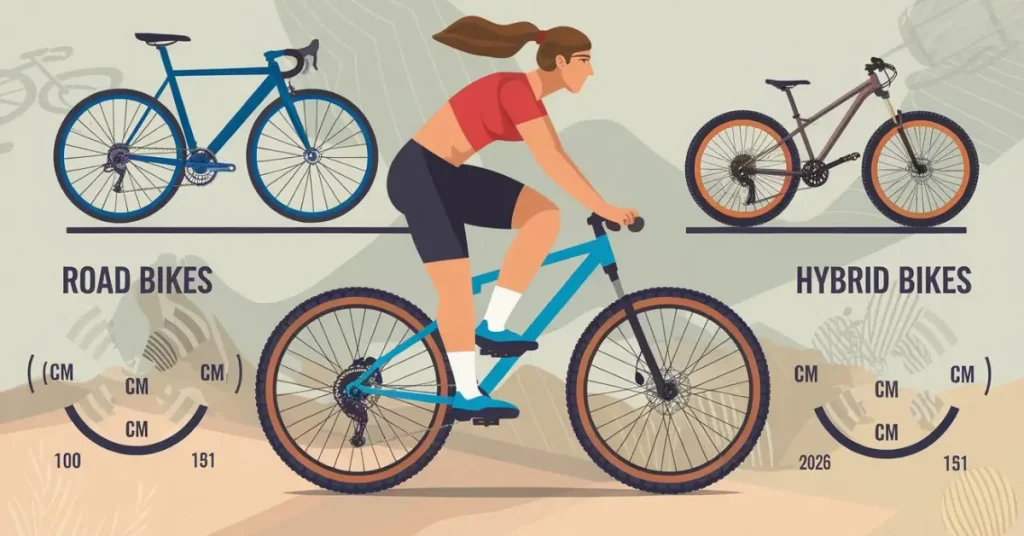
Height-Based Bike Size Chart
A quick way to estimate bike size is by using your height. Here’s a general guide:
Rider Height | Road Bike (cm) | Mountain Bike (inches) | Hybrid Bike (cm) |
4’10” – 5’2” | 47 – 50 cm | 13 – 15 in | 47 – 50 cm |
5’2” – 5’6” | 50 – 54 cm | 15 – 17 in | 50 – 54 cm |
5’6” – 5’10” | 54 – 56 cm | 17 – 19 in | 54 – 56 cm |
5’10” – 6’1” | 56 – 58 cm | 19 – 21 in | 56 – 58 cm |
6’1” – 6’4” | 58 – 61 cm | 21 – 23 in | 58 – 61 cm |
While height is a good starting point, it’s not the full picture. Two people of the same height can have different leg lengths, which brings us to…
How to Measure Your Inseam Correctly
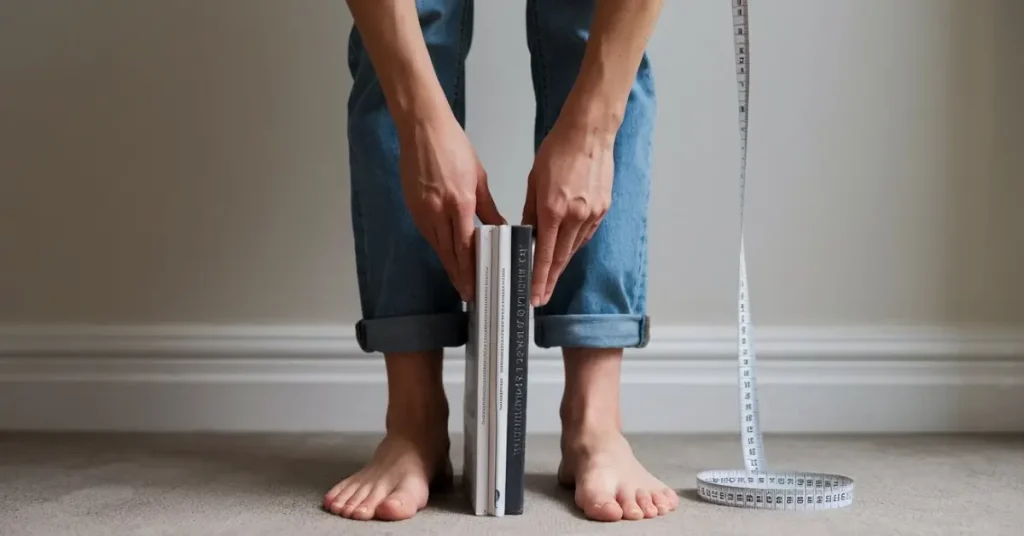
Your inseam is the length from the ground up to your crotch. It’s one of the best ways to find the right bike size.
How to measure:
- Stand with your feet about 6 inches apart.
- Place a book snugly between your legs, like a bike seat.
- Measure from the floor to the top of the book.
Short Answer: Inseam length is more accurate than height alone for choosing a bike size.
Inseam-Based Bike Frame Size Chart
Use your inseam to get a precise frame size:
Inseam Length | Road Bike (cm) | Mountain Bike (inches) | Hybrid Bike (cm) |
25 – 27 in | 47 – 50 cm | 13 – 15 in | 47 – 50 cm |
27 – 29 in | 50 – 54 cm | 15 – 17 in | 50 – 54 cm |
29 – 31 in | 54 – 56 cm | 17 – 19 in | 54 – 56 cm |
31 – 33 in | 56 – 58 cm | 19 – 21 in | 56 – 58 cm |
33 – 35 in | 58 – 61 cm | 21 – 23 in | 58 – 61 cm |
Inseam-based sizing helps avoid mistakes. If two people are 5’8”, but one has longer legs, they might need a bigger frame than the other.
Short Answer: Inseam is a better indicator than height for finding the perfect bike frame size.
How to Choose the Right Bike Frame Size
A. General Guidelines for Different Bike Types
Choosing the right bike frame size isn’t just about numbers—it’s about finding a bike that feels like an extension of you. Different bike types have unique sizing considerations, so let’s break it down:
Road Bikes
Road bikes are designed for speed and efficiency, which means they have a longer top tube and a more aggressive riding position. If you get a frame that’s too big, you’ll feel stretched out, leading to discomfort in your back and shoulders. Too small? You’ll feel cramped and inefficient.
Quick Tip: Stand over the top tube with both feet flat on the ground. You should have about 1-2 inches of clearance between your body and the frame.
Mountain Bikes
Mountain biking is all about control and maneuverability. A frame that’s too big makes it hard to handle rough trails, while a too-small frame can make climbing and pedaling uncomfortable.
Rule of Thumb: For mountain bikes, standover height is crucial. Aim for at least 2-4 inches of clearance between you and the top tube. This ensures you can hop off quickly when tackling tricky terrain.
Hybrid Bikes
Hybrid bikes blend road and mountain bike features, offering a comfortable upright position. The right size ensures better control and posture, reducing strain on your back and wrists.
Best Practice: Prioritize comfort. Since hybrid bikes are often used for commuting or leisure, a slightly smaller frame might be better for an upright riding position.
Gravel Bikes
Gravel bikes are like road bikes but designed for adventure. They have a more relaxed geometry for long rides on mixed terrain. A proper fit ensures you maintain control and endurance without excessive strain.
Key Consideration: A gravel bike should provide a balance between road bike speed and mountain bike stability. Make sure your reach isn’t too aggressive to avoid fatigue on long rides.
B. Adjusting for a Perfect Fit
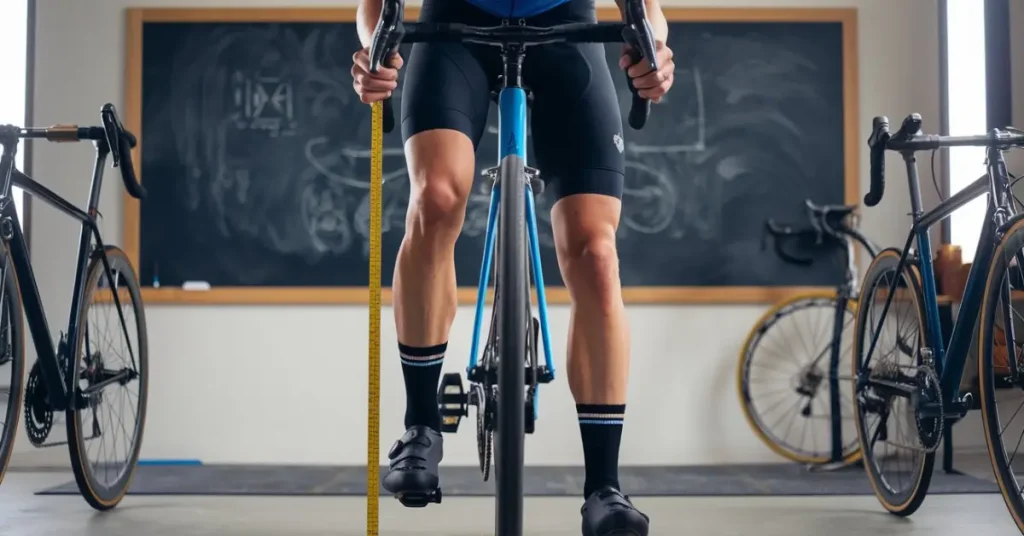
Even if you choose the right frame size, fine-tuning the fit is essential. Here’s what to check:
Stand-over Height and Clearance
For all bike types, stand-over height matters. A general rule is:
- Road bikes: 1-2 inches of clearance
- Mountain bikes: 2-4 inches of clearance
- Hybrid and gravel bikes: Around 1-2 inches of clearance
If you feel too close to the top tube when standing, the frame is likely too big.
Reach and Handlebar Positioning
Reach (the distance from the saddle to the handlebars) determines your comfort and control. If the reach is too long, you’ll overextend and strain your shoulders. If it’s too short, you’ll feel cramped and unstable.
Test it out: When seated, your elbows should have a slight bend while gripping the handlebars. Your back should feel relaxed, not hunched over or stretched out.
Saddle Height and Adjustment
Saddle height plays a huge role in efficiency and comfort. The right height prevents knee pain and maximizes pedaling power.
How to adjust:
- Sit on the saddle and place your heel on the pedal at its lowest position.
- Your legs should be fully extended without bending at the waist.
- When pedaling, you should have a slight bend in your knee (about 25-30 degrees) at the bottom of each stroke.
Final Thoughts
Choosing the right bike frame size is a mix of science and personal comfort. While charts and measurements are great starting points, always test-ride a bike to see how it feels. If in doubt, visit a local bike shop for expert fitting advice. A well-fitted bike means more enjoyable rides, better performance, and fewer aches—so take the time to get it right!
How to Choose the Right Bike Frame Size for Your Ride
Picking the right bike frame isn’t just about numbers—it’s about how you ride. Are you cruising around town, pushing your limits on long road rides, or hitting rugged mountain trails? Your riding style plays a huge role in finding the perfect fit. Let’s break it down.
Casual vs. Performance Fit
If you’re riding casually—commuting, weekend rides, or just enjoying the scenery—you’ll want a more relaxed fit. A slightly smaller frame keeps you upright and reduces strain on your back and wrists. Think comfort over speed.
Quick Tip: Casual riders should go for a relaxed fit with an upright posture for easy handling and comfort.
If performance is your goal—whether it’s road racing, endurance cycling, or mountain biking—you’ll want a more aggressive fit. A longer frame puts you in a lower, more aerodynamic position. This helps with speed and power transfer.
Quick Tip: Performance riders should choose a frame that allows a lower, stretched-out position for speed and efficiency.
Frame Geometry and Comfort
Not all frames feel the same. Even if two bikes have the same size, their geometry—how the tubes are shaped and connected—affects comfort and performance.
- Endurance road bikes have a shorter top tube and higher handlebars for comfort on long rides.
- Race road bikes have a longer reach and lower handlebars for aerodynamics.
- Mountain bikes come in different styles—some designed for climbing, others for aggressive downhill riding.
- Hybrid bikes prioritize comfort with an upright position.
Think about how you want your ride to feel. Do you want stability for long rides? A quick, responsive bike? Geometry makes all the difference.
Quick Tip: Frame geometry affects comfort and performance, so choose based on your riding needs.
Test Rides and Professional Fitting
No chart or calculator can replace how a bike actually feels. A test ride lets you check if the reach is right, your feet touch the ground comfortably, and the bike handles well.
A professional bike fitting takes it a step further. A trained fitter will measure your flexibility, body proportions, and riding habits to fine-tune the fit—adjusting saddle height, stem length, and even crank arms.
Quick Tip: Always test-ride a bike before buying, and consider a professional fitting for the best results.
Using a Bike Frame Size Calculator

If you can’t test-ride a bike before buying, a size calculator can help. These online tools use your height and inseam to recommend a frame size.
How Online Bike Size Calculators Work
Most calculators ask for:
- Your height
- Your inseam measurement
- The type of bike you’re looking for (road, mountain, hybrid, etc.)
Some even factor in arm length and flexibility for more precise recommendations.
Quick Tip: Bike size calculators use height, inseam, and bike type to suggest a good frame size.
Pros and Cons of Bike Size Calculators
Pros:
- Quick and easy
- Gives a good starting point
- Useful for online shopping
Cons:
- Doesn’t account for personal preference
- Can’t replace a test ride
- May not factor in frame geometry differences
Calculators are helpful, but they’re just a guide. The best way to find your perfect fit is to ride the bike and make adjustments as needed.
Quick Tip: Calculators provide a starting point, but a test ride and professional fitting give the best results.
Final Thoughts
Finding the right bike frame size is about matching your fit to your riding style. Whether you’re riding for fun, speed, or adventure, a well-sized bike makes every ride better. Use charts and calculators as a guide, but don’t skip test rides and expert advice to get the perfect fit!
Common Mistakes When Choosing a Bike Frame Size
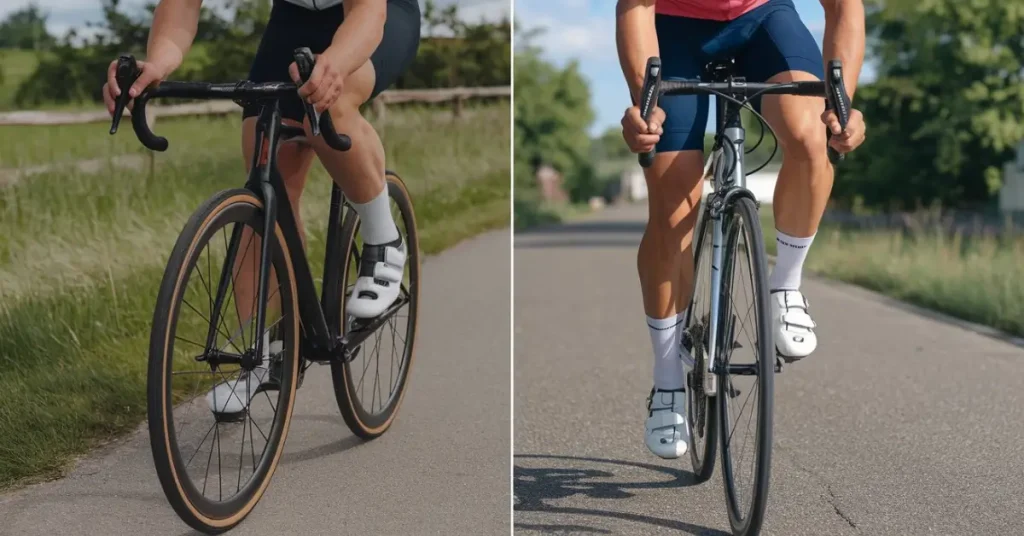
Relying Only on Height Without Considering Inseam
Ever heard someone say, “I’m 5’10”, so I need a 56cm road bike”? Sounds logical, right? But here’s the thing—height alone doesn’t tell the full story. Your legs could be long, short, or somewhere in between, and that changes everything.
For example, I once helped a friend pick out a bike. He’s the same height as me, but his legs are longer, and his torso is shorter. The frame size that fit me perfectly made him feel cramped. Why? Because inseam length determines how comfortably you can reach the pedals and how well the bike fits your body.
Short Answer: Your inseam matters more than your height for finding the right bike frame size.
Ignoring Bike Type Differences
Not all bikes follow the same sizing rules. A 54cm road bike isn’t the same as a 54cm mountain bike. I learned this the hard way when I switched from a road bike to a mountain bike and assumed the sizes matched. Spoiler alert: They didn’t.
Road bikes have longer frames for an aerodynamic ride, while mountain bikes are shorter for better control. Hybrid bikes fall somewhere in between. If you switch bike types, don’t assume your usual size will work—always check the specific sizing for that bike.
Short Answer: Different bike types have different sizing, so always check the specific chart before choosing.
Choosing a Frame Too Large or Small to “Grow Into”
This mistake is common, especially when buying bikes for kids or beginners. The logic is, “I’ll grow into it,” or “A bigger bike is a better investment.” But here’s the problem: a bike that’s too big is harder to control, and one that’s too small forces you into an awkward riding position.
I once tried riding a frame one size too big because it was a great deal. Within minutes, I felt unstable, constantly stretching to reach the handlebars. On longer rides, my lower back and shoulders paid the price. A bike should fit you now, not in the future.
Short Answer: A bike that doesn’t fit properly leads to discomfort, poor control, and potential injuries.
Final Thoughts
Picking the right bike frame size isn’t just about numbers—it’s about how you feel on the bike. Measure your inseam, check the bike type, and never size up or down thinking it’ll work out later. A well-fitted bike makes every ride smoother, faster, and pain-free. So take the time to get it right!
FAQs: Answering Common Questions
What is the correct frame size for my height?
You might think, “I’m 5’9”, so I just need a chart to tell me my size.” But here’s the truth—height alone isn’t enough. Two people of the same height can have completely different leg lengths, which affects how a bike fits.
🔹 Short Answer: Use your inseam measurement, not just your height, to find the right frame size. Most bike brand websites have detailed sizing charts based on inseam length.
For example, I’m 5’10”, but my inseam is longer than average. That means I fit better on a 56cm road bike, while someone else my height might feel more comfortable on a 54cm. Always check the brand’s size chart and, if possible, test-ride before buying.
How do I determine my bike frame size without a calculator?
No fancy tools? No problem! Here’s a quick way to estimate your size:
- Stand barefoot against a wall and measure your inseam (floor to crotch).
- Multiply by 0.67 for road bikes or 0.58 for mountain bikes to get your ideal frame size in centimeters.
- Compare your result with a brand’s size chart to fine-tune your choice.
🔹 Short Answer: Measure your inseam and multiply by 0.67 (road) or 0.58 (mountain) to estimate your frame size.
I once bought a bike without checking my inseam and ended up with a frame that was just a bit too small. It felt fine for short rides but became uncomfortable on longer trips. Lesson learned: a quick inseam check can save you from an awkward fit!
Can I ride a bike that’s slightly too big or small?
Technically? Yes. Comfortably? Not really. A slightly too-small bike can feel cramped, while a too-big bike is harder to control—especially when stopping or turning.
🔹 Short Answer: Riding the wrong size bike can lead to discomfort, poor handling, and even injuries.
I once rode a bike that was a size too big because it was a great deal. Within 10 minutes, I was stretching awkwardly to reach the handlebars. By the end of the ride, my shoulders and lower back were killing me. A proper fit isn’t just about comfort—it affects how well you ride.
How does frame material affect sizing and comfort?
Frame material doesn’t change the size itself, but it affects how the bike feels. Carbon frames absorb road vibrations better, making them smoother. Aluminum frames are lighter but can feel stiff. Steel frames are strong and comfy but heavier.
🔹 Short Answer: Carbon is smooth, aluminum is stiff and light, and steel is durable but heavier. Choose based on comfort and ride style.
If you ride long distances, a carbon or steel frame will feel better on rough roads. If you want a responsive, lightweight ride, aluminum might be your best bet. Always test ride to see what feels best for you!
Conclusion
Choosing the right bike frame size isn’t just about numbers—it’s about how you feel on the bike. A well-fitted bike makes every ride smoother, faster, and pain-free.
🔹 Short Answer: Measure your inseam, check the bike type, and never size up or down thinking it’ll work out later.
I’ve made the mistake of picking the wrong size before, and trust me—it’s not worth it. Too big? You’ll feel stretched out and unstable. Too small? Cramped rides and sore muscles. The perfect fit? That’s when cycling feels effortless.
So, here’s the game plan: Measure carefully, test-ride whenever possible, and don’t just rely on height charts. If you’re buying online, use a bike size calculator to get a solid starting point. But if you really want to nail the fit, head to a local bike shop. Nothing beats an expert fitting and an actual test ride.
🔹 Short Answer: Visit a local bike shop or use a size calculator to confirm your ideal frame size before buying.
At the end of the day, the right bike should feel like an extension of you. Get the fit right, and every ride—whether it’s a casual cruise or a high-speed adventure—will feel amazing.
